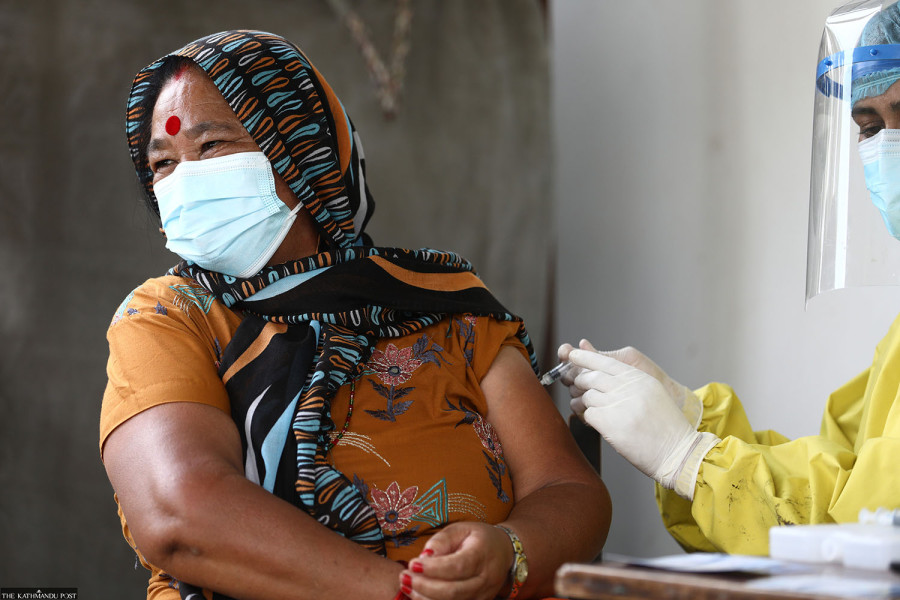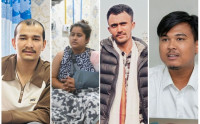National
Don’t wait for free jabs, pay to secure them, World Bank tells Nepal
The donor agency, which has provided $100 million for vaccine procurement, says money should not be an issue when it comes to vaccinating the population.
Sangam Prasain
As Nepal scrambles to secure vaccines against Covid-19, the World Bank, a major donor which has committed funds to buy the jabs, has said the country must not wait for free vaccines and order them by paying.
Nepal should not wait for free vaccines and should immediately reserve them by paying, Faris Hadad-Zervos, World Bank’s country director for Nepal, Sri Lanka and the Maldives, told Nepali journalists during a virtual meeting on Thursday.
He urged Nepal to immediately sign up for COVAX's second window under which countries can purchase vaccines.
After a devastating second coronavirus wave which claimed nearly 6,000 lives and sickened hundreds of thousands, a third wave threat is looming large. But Nepal’s vaccination coverage remains woeful.
According to data provided by the Ministry of Health and Population on Thursday, 2.61 million Nepalis have got their first doses of Covid-19 vaccine, and of them just 933,868 have received both doses. Only around 3 percent of the population has been fully vaccinated so far.
Nepal has so far received 1 million doses of Covishield, the AstraZeneca type vaccine manufactured by the Serum Institute of India, and 1.8 million doses of Vero Cell, developed and manufactured by China’s Sinopharm, under grant assistance.
Besides that, the Serum Institute supplied 1 million doses of Covishield for which Nepal paid. COVAX, the international vaccine sharing scheme backed by the United Nations, had also supplied 348,000 doses of Covishield.
After the supplies dried up, the government then reached out to various countries to secure additional doses, but given the supply chain constraints, some private firms, including American companies, expressed their inability to sell the jabs before 2022.
Nepal, however, has managed to secure 4 million doses of Vero Cell from Sinopharm, a Chinese state-owned pharmaceutical company, under a non-disclosure agreement, which bars the buyer from disclosing the price.
Faris told reporters on Thursday that money should not be an issue for Nepal to buy the jabs.
“The World Bank has provided $100 million [nearly Rs12 billion] for vaccine procurement,” said Faris. “Another $160 million [nearly Rs19 billion] has been set aside by the Asian Development Bank for Nepal.
From these two sources, according to him, Nepal will have $260 million (about Rs30 billion) to procure vaccines.
“Money is not the issue,” he said. “The issue is how Nepal will plan to vaccinate all its population.”
Nepal needs to inoculate 72 percent of its 30 million population, or 22 million people, for which it will need 44 million doses of two-shot vaccine. The UN-backed COVAX had committed to providing 13 million doses, enough to inoculate around 20 percent of the population.
An additional 348,000 doses of AstraZeneca vaccine and around 1.5 million doses of Johnson & Johnson vaccine, the only single-shot jab, are expected to be supplied to Nepal under the COVAX facility within July.
But that won’t be enough, and Nepal needs to work on a war footing to secure more doses, before another wave hits the country.
Nepal also needs the AstraZeneca vaccine doses immediately to give booster doses to the 1.4 million people who took their first shots in the second week of March.
Faris said that the Nepal government has taken a good move to procure vaccines from China, but it will not meet the demand.
Responding to journalists' question whether Nepal can procure vaccines under the non-disclosure agreement (NDA) with the aid supported by the development partners, Faris said that every country has signed such deals.
“NDA is not a restriction. Nepal should ensure that there is transparency in the procurement process,” said Faris.
The multilateral funding agency has said that Nepal can procure any vaccine which is approved by the World Health Organisation.
The COVAX facility initially said that 1.9 million doses of its total commitment would arrive in Nepal by March. But after India faced a devastating second wave, COVAX was hit hard, as it was banking on the Serum Institute of India, the world’s largest vaccine manufacturer by volume.
“It’s not easy to get the vaccine. We assume that in the next six months, there will be a huge demand for vaccines. So Nepal needs proper planning,” said Faris. “Today all roads lead to vaccines because Covid-19 is not in our control.”
According to Faris, Nepal must ensure that it gets as many doses of vaccine during the second window of the COVAX facility, which will be available from next month.
The World Bank said that 2020 was a devastating year, not only for Nepal but the whole world.
Nepal’s economy faced headwinds, technically recording an economic recession for the first time in almost 40 years with the country witnessing negative growth rates for two consecutive quarters because of the Covid-19 pandemic-induced supply and demand shock on the economy.
According to the Central Bureau of Statistics, in the fourth quarter of the last fiscal year 2019-20, the country’s economic growth rate, or output of the gross domestic product, plunged 15.4 percent compared to the same period in 2018-19, which resulted in a year-on-year negative growth rate of 2.1 percent.
This was the first annual negative growth rate since 1982-1983 when Nepal’s economic growth rate plunged -2.97 percent, according to the World Bank.
This fiscal year 2020-21, ending mid-July, the World Bank has projected Nepal to grow at the rate of 2.7 percent and 3.9 percent in the fiscal year 2021-22.
But then Nepal faced the second wave of the pandemic in April and most of the country was under lockdown for almost two months from April 29. Restrictions are still in place.
However, remittances have been propping up the economy. Despite several hiccups in Nepal’s labour market, in the 10 months of this fiscal year, Nepal saw its remittance earning grow by double digits.
According to Nepal Rastra Bank, remittance inflows increased 19.2 percent to Rs809.89 billion in 10 months against a decrease of 6.3 percent in the same period last fiscal year.
Remittance financed more imports and consumption.
“This all shows that Nepal's economy is in a recovery phase,” said Faris. “As a development partner, we are cautiously watching what Nepal is doing to stimulate the economy.”
The cost of the pandemic is huge.
According to the Ministry of Health and Population, 9,320 Nepalis have lost their lives since the beginning of the pandemic, more than 6,000 of whom died during the ongoing second wave.
Experts have warned that with restrictions loosened, the peak of the second wave may yet to be reached. On Thursday, 1,218 more people were reported infected, taking the tally to 651,380, and 29 succumbed to Covid-19 related complications. Positivity rate continues to be high which on Thursday stood at nearly 23 percent.
“At the end of the day, Nepal needs vaccines,” said Faris. “It has to vaccinate all its people.”




 17.12°C Kathmandu
17.12°C Kathmandu





%20(1).jpg&w=200&height=120)







%20(1).jpg&w=300&height=200)

